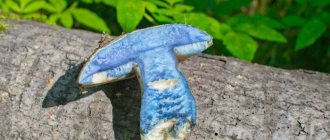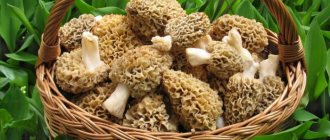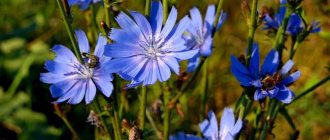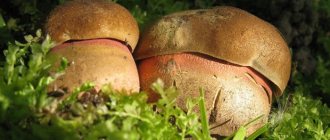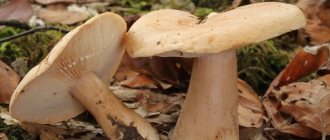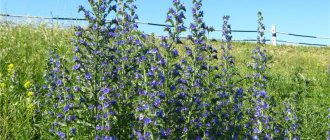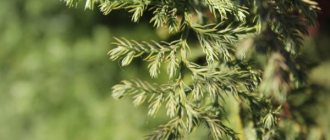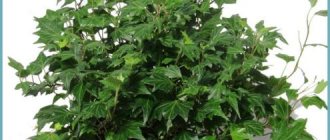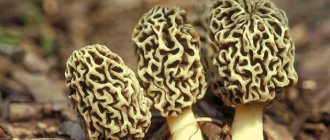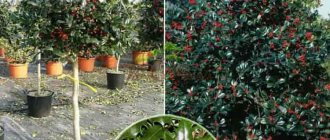How to distinguish morel mushrooms from strings: comparison, similarities and differences
Morel and string
Morel and string mushrooms are very similar in appearance. It is difficult for an inexperienced mushroom picker to immediately spot the differences. Let's compare these two types of mushroom. Here are the similarities and differences:
- In morels, the cap has a regular external structure: conical or round. The lines have an unusual shape and resemble a brain.
- The stem of morels is smooth - without deep folds or convolutions, and long. This mushroom rises well from the ground, it seems to stretch upward. The stem of the mushroom is almost invisible, it is squat and one can say that this mushroom, on the contrary, goes into the ground.
- Morels are smaller than lines.
- Morels have a nutty or mushroom smell , while the flesh of the string is almost odorless.
- The morel is empty in the middle and filled with creamy or light-colored pulp . The line is also hollow inside, but its flesh resembles large convolutions.
At first glance, it seems that these two types of mushroom are similar, but if you look at them in more detail, the differences are obvious.
Which family do they belong to?
Despite the frequent confusion in names, mushrooms can be distinguished not only by name and distinctive features, but also by classification. Strings belong to the genus of marsupials of the Discinaceae family. Morels are edible species of the morel genus, translated in Latin as Phallus esculentus. The unusual name is associated with the shape of the mushroom, visually reminiscent of the outlines of manhood.
Scientific information is, of course, useful, but not very important when collecting. It is much more important for a mushroom picker to find out the differences between morels and strings by studying whether they are edible or not, as well as visual photos of the differences that correspond to the classification of each family. The comparative description presented in the pictures will allow even a beginner to determine the difference when going fishing.
It has been scientifically proven that only morels can be eaten. It is better to avoid the lines in order to avoid poisoning and intoxication of the body. Due to statistics confirming a large number of poisonings, you should not risk your health and the well-being of your family and friends.
Where, in what forest and when can you pick morel mushrooms?
Morels
Morel mushrooms appear only on soils favorable for their growth, namely:
- In coniferous and mixed forest plantations and forests, on the edges, along roads, clearings
- In garden plots
- On the ground after fires
- In parks and gardens
Morels grow equally well in fertile soils as well as in sandy and sandy loam soils. Finding such a mushroom is not easy, as its cap blends in with the color of last year’s foliage and dry grass. These mushrooms are collected in April-May.
Varieties of morels with photos, are they poisonous?
Unfortunately, stitches and morels differ not only externally, but also internally. The first ones are strictly forbidden to consume due to the poison content in the pulp, which is dangerous for the body. The latter can and should be used as food after heat treatment. Morel varieties include both edible and conditionally edible species that are acceptable for consumption.
No. 1 - common morel
The classic representative of its species is Morchella esculenta or the common morel. Its distinctive feature for many years has been the merging of the cap with the stem. A single form sets it apart from its peers.
Externally, the cap is ovoid, elongated in shape with cells of varying depths. The leg is light, closer to a snow-white shade, and can reach up to 12 cm in length. The hat is painted in any shade of yellow or brown, from light to dark.
Of the pests encountered during the period of mycelium germination, slugs and other crawling insects hiding in the flesh of the cap become more active. To prevent them from getting into food, after picking, the mushrooms are washed and soaked in salt water for one hour. The procedure gets rid of not only pests, but also dirt that has adhered during the germination period.
No. 2 - conical morel
Morchella conica remains a species of the morel family found in humid areas. The conical shape, combining the cap and the stem, was transferred to the name of the species. The morel is conical and stands out in the area for the following differences:
a hollow but cellular cap with a pointed shape, reaching a length of up to 10 cm, not counting the stem. Usually, the size of the upper part is larger than the lower part. The color scheme is light yellow, with a slight tint of brown. In rare cases, it can be colored to dark brown;
the leg is cylindrical, empty inside. The height is small, in rare cases reaching 6 cm. The diameter does not exceed 1.5 cm. Externally, it is covered with velvet coating and longitudinal grooves. The color scheme is white, less often light yellow.
No. 3 - tall morel
A large morel, similar to a conical one, has the unusual name Morchella elata. Translated into Russian, it is characterized as high. The difference between the species remains the dark shade of the cap and the large, one might even say tall, fruiting body. The length of the “high” reaches up to 35 cm.
The hat resembles a cone, reaching a length of up to 12 cm and a diameter of no more than 2.5. On the top of the mushroom you can see deep cells. The color scheme is red, less often brown with a black tint. The partitions between the cells are expressive, differing in color from the fruit itself. They often have an olive-red tone.
The leg is tall, slightly longer than the cap. It can be an elongated white shape, no more than 16 cm. In adult mushrooms it can be darker, from cream to light coffee shade.
No. 4 - steppe morel
The name speaks for itself! Morchella steppicola, or popularly known as the largest morel (photo below), is found throughout almost the entire territory of Russia. It can be found in April and May on vast steppes, fields, swampy areas and even forest belts where moss sprouts.
The hat is similar in roundness to the stitch, but has a soft creamy tint. It can reach up to 25 cm in width and height.
The leg is snow-white, short and empty. The height in rare cases reaches 2.5 cm.
In order not to confuse the steppe morel with a line that is poisonous or conditionally edible, it is recommended to navigate not only by the signs, but also by a visual photo. With a correct visual assessment of the differences, even a beginner will be able to identify an edible mushroom from a forbidden one that is not recommended for collection.
Is it necessary and how to peel and process morel mushrooms?
Morels
do not need to be peeled and filmed. It is important to process them correctly before cooking:
- First you need to soak the mushrooms in salted water overnight - 2 tablespoons of salt per 10 liters of water. This type of water removes dirt better.
- Then you should boil the mushrooms for half an hour . Large mushrooms must be cut in half. After boiling, drain the water.
- Add water again and cook for 20 minutes.
- Change the water again and boil the mushrooms again for 20 minutes.
After this treatment, the mushrooms can be fried, boiled, or cooked with them in various dishes.
Ordinary stitch
Many people in the forest have encountered this mushroom; it appears a little earlier than the morel and its characteristic feature is the hat (sometimes reaching enormous sizes). The mushroom's hat is brain-shaped and irregularly rounded. Color ranges from light brown to dark, dark chocolate color. The leg is hollow, narrowed towards the base, sometimes of an uneven shape. Grows from late March to early June (in some areas)
Is it possible to eat lines
Opinions on the edibility of this mushroom are very contradictory. In Europe, the mushroom is considered poisonous. There have also been fatal cases of poisoning by this mushroom. In Russia, I am not aware of any cases of poisoning with this mushroom. But nevertheless, according to scientists, this mushroom is considered poisonous. Contains a substance reminiscent of the poison of the toadstool, a substance called gyrometrin.
Stitch poisoning is very common in Poland. It is likely that the amount of gyrometrine in “our” lines is small. If you are going to cook this mushroom, boil it in several waters (each time you should drain the water and add new water), then fry it. Some sources say that after drying for more than a month, gyrometrine evaporates. On the 10th day of drying, the amount of gyrometrin is reduced by 90 percent.
Symptoms of stitch poisoning
The lethal dose of gyrometrine is 10-30 mg per kg of body weight for children and 20-50 mg/kg for adults. Gyrometrine destroys red blood cells; gyrometrine poisoning can lead to liver destruction. Some sources say that the line exhibits carcinogenic properties.
Symptoms of poisoning: diarrhea, vomiting, stomach pain. Poisoning occurs within 6-12 hours, although it may be earlier.
Initially they manifest themselves as facial redness, nausea, diarrhea, and stomach pain. Further possible tremors, convulsions, lethargy, ataxia, dizziness and severe headaches, as well as fever (the latter is not typical for any mushroom poisoning and occurs only as a symptom of stitch poisoning). In most cases, after such manifestations, gradual recovery occurs within 2-6 days.
Medicinal properties line
The line has medicinal properties. Tincture from the lines is an excellent pain reliever, which was used for rheumatic and joint pain, pancreatitis, etc.
Recipe for making tincture from strings
The mushrooms need to be dried (they greatly decrease in size after drying) and chopped. 10 grams of powder are mixed with 150 ml. vodka. Stir and cover tightly and leave in the refrigerator for 2 weeks.
Rub the tincture into the sore spots and cover with a warm scarf, preferably a prickly one (woolen).
By the way, previously, eyes were washed with conjunctivitis with an aqueous infusion of the mushroom.
Are morel mushrooms healthy: benefits and harms?
Morel Mushroom
Scientists biologists have conducted many studies with morel mushrooms, thanks to which they discovered that such mushrooms contain the substance FD4.
- This is a polysaccharide compound that helps strengthen the eye muscle.
- Currently, many medications have been created that help cope with clouding of the eye lens.
- The substances that make up morels help cleanse the blood and lymph, increase immunity, appetite and the functioning of the gastrointestinal tract.
- The harm of these mushrooms is that they can be confused with poisonous strings - they are very similar in appearance.
In addition, morels have a low calorie content - 16 kcal per 100 grams. But you shouldn’t eat a lot of these mushrooms, as this heavy food may cause indigestion in the intestines.
Which one is poisonous?
Morels are suitable for preparing various dishes. Some morels are classified as edible, while others are classified as conditionally edible. It is strictly forbidden to eat the strings raw - they are poisonous. Some varieties are allowed to be used in cooking, but only after special processing.
The poison content in the lines is not constant - it changes depending on the place of growth and the weather. They are especially poisonous if the spring is dry.
The lines are full of gyromitrin - this is a poison that is not destroyed even after prolonged boiling. In a number of countries, the lines are clearly classified as poisonous mushrooms in their entirety.
Can there be morel mushroom poisoning?
Morel Mushrooms
It has long been known that mushrooms absorb harmful toxins from the soil. Therefore, it is not recommended to collect any mushrooms in contaminated areas. This also applies to morels. Mild poisoning may occur if such mushrooms are not prepared correctly, since each organism perceives helvella acid differently. Therefore, before cooking, thoroughly soak the mushrooms and boil, changing the water 3 times.
Don't eat morels in large quantities. Serve them as a delicacy - tasty and original.
How to cook morels
Morels are boiled, fried and dried. Before use, they must be boiled, the broth drained, and the mushrooms washed in cold water. After this, they can be safely fried, stewed and boiled. Harmful substances are completely neutralized during drying. Morels are stewed in sour cream, milk and butter. Before this, they are boiled and the water is drained.
Morels in oil. To do this, boil fresh morels for 10 - 15 minutes, drain in a colander and rinse with cold water or squeeze out. The drained water should not be consumed as food. Mushrooms are cut into slices, seasoned with salt, pepper and sprinkled with lemon juice. Fry covered for another 15 - 20 minutes.
Pancakes with morels. In America, this dish is served at gala dinners of the Morel Society. To do this, fried morels are wrapped in pancakes, which are then fried on all sides.
{SOURCE}
Lines where to grow in 2021?
Years go by, but the gathering places do not change. Like morels, stitches can be found in almost any forested area, plantings of birch and aspens, open fields and meadows. Less commonly, mushrooms are found near swamps and rivers, where water nourishes the soil, maintaining high humidity for several weeks longer.
In Crimea and Kuban
Like morels, morels sprout in different places, depending on the variety. Some prefer pine forests, coniferous plantings and clearings. This applies in particular to the giant line. But the “autumn” one prefers deciduous and mixed zones, open areas adjacent to the river mouth.
